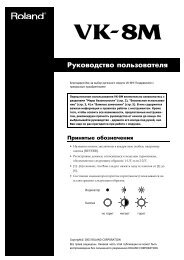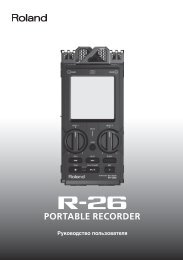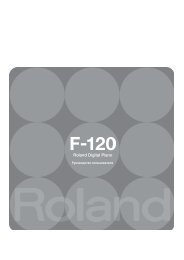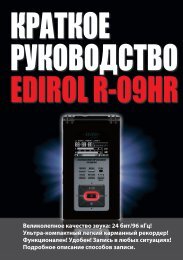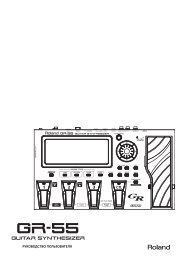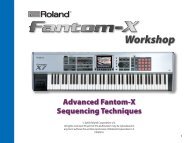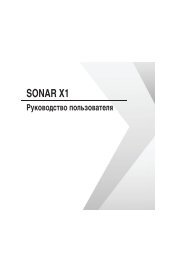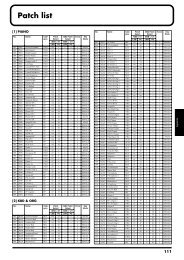Owner's Manual - Roland
Owner's Manual - Roland
Owner's Manual - Roland
- No tags were found...
Create successful ePaper yourself
Turn your PDF publications into a flip-book with our unique Google optimized e-Paper software.
MIDI Implementation6. Supplementary Material■Decimal and Hexadecimal Table(An “H” is appended to the end of numbers in hexadecimal notation.)In MIDI documentation, data values and addresses/sizes of Exclusive messages, etc. areexpressed as hexadecimal values for each 7 bits.The following table shows how these correspond to decimal numbers.+——————+——————++——————+——————++——————+——————++——————+——————+| D | H || D | H || D | H || D | H |+——————+——————++——————+——————++——————+——————++——————+——————+| 0 | 00H || 32 | 20H || 64 | 40H || 96 | 60H || 1 | 01H || 33 | 21H || 65 | 41H || 97 | 61H || 2 | 02H || 34 | 22H || 66 | 42H || 98 | 62H || 3 | 03H || 35 | 23H || 67 | 43H || 99 | 63H || 4 | 04H || 36 | 24H || 68 | 44H || 100 | 64H || 5 | 05H || 37 | 25H || 69 | 45H || 101 | 65H || 6 | 06H || 38 | 26H || 70 | 46H || 102 | 66H || 7 | 07H || 39 | 27H || 71 | 47H || 103 | 67H || 8 | 08H || 40 | 28H || 72 | 48H || 104 | 68H || 9 | 09H || 41 | 29H || 73 | 49H || 105 | 69H || 10 | 0AH || 42 | 2AH || 74 | 4AH || 106 | 6AH || 11 | 0BH || 43 | 2BH || 75 | 4BH || 107 | 6BH || 12 | 0CH || 44 | 2CH || 76 | 4CH || 108 | 6CH || 13 | 0DH || 45 | 2DH || 77 | 4DH || 109 | 6DH || 14 | 0EH || 46 | 2EH || 78 | 4EH || 110 | 6EH || 15 | 0FH || 47 | 2FH || 79 | 4FH || 111 | 6FH || 16 | 10H || 48 | 30H || 80 | 50H || 112 | 70H || 17 | 11H || 49 | 31H || 81 | 51H || 113 | 71H || 18 | 12H || 50 | 32H || 82 | 52H || 114 | 72H || 19 | 13H || 51 | 33H || 83 | 53H || 115 | 73H || 20 | 14H || 52 | 34H || 84 | 54H || 116 | 74H || 21 | 15H || 53 | 35H || 85 | 55H || 117 | 75H || 22 | 16H || 54 | 36H || 86 | 56H || 118 | 76H || 23 | 17H || 55 | 37H || 87 | 57H || 119 | 77H || 24 | 18H || 56 | 38H || 88 | 58H || 120 | 78H || 25 | 19H || 57 | 39H || 89 | 59H || 121 | 79H || 26 | 1AH || 58 | 3AH || 90 | 5AH || 122 | 7AH || 27 | 1BH || 59 | 3BH || 91 | 5BH || 123 | 7BH || 28 | 1CH || 60 | 3CH || 92 | 5CH || 124 | 7CH || 29 | 1DH || 61 | 3DH || 93 | 5DH || 125 | 7DH || 30 | 1EH || 62 | 3EH || 94 | 5EH || 126 | 7EH || 31 | 1FH || 63 | 3FH || 95 | 5FH || 127 | 7FH |+——————+——————++——————+——————++——————+——————++——————+——————+D: decimalH: hexadecimal* Decimal values such as MIDI channel, bank select, and program change are listed as onegreater than the values given in the above table.* A 7-bit byte can express data in the range of 128 steps. For data where greater precisionis required, we must use two or more bytes. For example, two hexadecimal numbers aabbH expressing two 7-bit bytes would indicate a value of aa x 128+bb.* In the case of values which have a +/- sign, 00H = -64, 40H = +/-0, and 7FH = +63, sothat the decimal expression would be 64 less than the value given in the above chart. Inthe case of two types, 00 00H = -8192, 40 00H = +/-0, and 7F 7FH = +8191. For example, ifaa bbH were expressed as decimal, this would be aa bbH - 40 00H = aa x 128+bb - 64 x128.* Data marked “Use nibbled data” is expressed in hexadecimal in 4-bit units. A valueexpressed as a 2-byte nibble 0a 0bH has the value of a x 16+b. What is the decimal expression of 5AH?From the preceding table, 5AH = 90 What is the decimal expression of the value 12 34H given ashexadecimal for each 7 bits?From the preceding table, since 12H = 18 and 34H = 5218 x 128+52 = 2356 What is the decimal expression of the nibbled value 0A 0309 0D?From the preceding table, since 0AH = 10, 03H = 3, 09H = 9, 0DH = 13((10 x 16+3) x 16+9) x 16+13 = 41885 What is the nibbled expression of the decimal value 1258?■Examples of Actual MIDI Messages 92 3E 5F9n is the Note-on status, and n is the MIDI channel number. Since 2H = 2, 3EH = 62, and5FH = 95, this is a Note-on message with MIDI CH = 3, note number 62 (note name is D4),and velocity 95. CE 49CnH is the Program Change status, and n is the MIDI channel number. Since EH = 14 and49H = 73, this is a Program Change message with MIDI CH = 15, program number 74. EA 00 28EnH is the Pitch Bend Change status, and n is the MIDI channel number. The 2nd byte (00H= 0) is the LSB and the 3rd byte (28H = 40) is the MSB, but Pitch Bend Value is a signednumber in which 40 00H (= 64 x 12+80 = 8192) is 0, so this Pitch Bend Value is28 00H - 40 00H = 40 x 12+80 - (64 x 12+80) = 5120 - 8192 = -3072If the Pitch Bend Sensitivity is set to 2 semitones, -8192 (00 00H) will cause the pitch tochange -200 cents, so in this case -200 x (-3072) é÷ (-8192) = -75 cents of Pitch Bend is beingapplied to MIDI channel 11. B3 64 00 65 00 06 0C 26 00 64 7F 65 7FBnH is the Control Change status, and n is the MIDI channel number. For Control Changes,the 2nd byte is the control number, and the 3rd byte is the value. In a case in which two ormore messages consecutive messages have the same status, MIDI has a provision called“running status” which allows the status byte of the second and following messages to beomitted. Thus, the above messages have the following meaning.B3 64 00 MIDI ch.4, lower byte of RPN parameter number: 00H(B3) 65 00 (MIDI ch.4) upper byte of RPN parameter number: 00H(B3) 06 0C (MIDI ch.4) upper byte of parameter value: 0CH(B3) 26 00 (MIDI ch.4) lower byte of parameter value: 00H(B3) 64 7F (MIDI ch.4) lower byte of RPN parameter number: 7FH(B3) 65 7F (MIDI ch.4) upper byte of RPN parameter number: 7FHIn other words, the above messages specify a value of 0C 00H for RPN parameter number00 00H on MIDI channel 4, and then set the RPN parameter number to 7F 7FH.RPN parameter number 00 00H is Pitch Bend Sensitivity, and the MSB of the value indicatessemitone units, so a value of 0CH = 12 sets the maximum pitch bend range to +/-12semitones (1 octave). (On GS sound generators the LSB of Pitch Bend Sensitivity is ignored,but the LSB should be transmitted anyway (with a value of 0) so that operation will becorrect on any device.)Once the parameter number has been specified for RPN or NRPN, all Data Entry messagestransmitted on that same channel will be valid, so after the desired value has beentransmitted, it is a good idea to set the parameter number to 7F 7FH to prevent accidents.This is the reason for the (B3) 64 7F (B3) 65 7F at the end.It is not desirable for performance data (such as Standard MIDI File data) to contain manyevents with running status as given in . This is because if playback is haltedduring the song and then rewound or fast-forwarded, the sequencer may not be able totransmit the correct status, and the sound generator will then misinterpret the data. Takecare to give each event its own status.It is also necessary that the RPN or NRPN parameter number setting and the value settingbe done in the proper order. On some sequencers, events occurring in the same (orconsecutive) clock may be transmitted in an order different than the order in which theywere received. For this reason it is a good idea to slightly skew the time of each event (about1 tick for TPQN = 96, and about 5 ticks for TPQN = 480).* TPQN: Ticks Per Quarter Note16 ) 125816 ) 78 ...1016 ) 4 ...140 ... 4Since from the preceding table, 0 = 00H, 4 = 04H, 14 = 0EH, 10 = 0AH, the result is: 00 04 0E0AH.328



